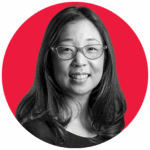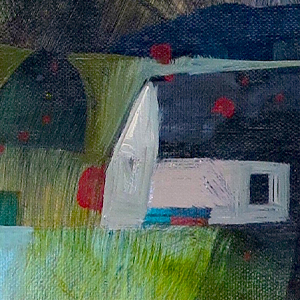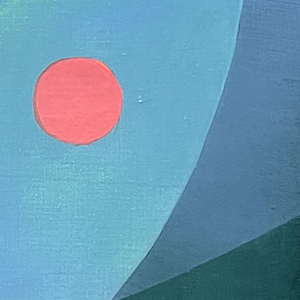
Interlude: Meaningful Work
The Soul of Work
Navigating Purpose in an Age of Spaghetti Pathways
Michelle Weise
Artwork: “Bloom Time” by Denys Golden © 2025
When I first met Dana Allen Walsh, a senior pastor at a progressive church in my hometown, it quickly became clear that we shared an abiding interest in the soul of work—the search for purpose and meaning through our vocations.
At the time, I was just about to deliver a commencement address titled “Nothing Is Wasted,” a message to young college graduates about the hidden value of detours, failures, and apparent dead-ends. I urged them not to view these moments as a waste of time or resources, but rather as signs of growth. The worst moments can often serve as fertile ground for profound growth and unexpected transformation.
What I did not anticipate was how deeply this message would resonate with Dana. She told me it mirrored the final sermon she had preached at her former church, where she reflected on the messy beginnings of a community garden—one that starts, as she put it, with “a huge pile of stinky compost.” To her, this compost was a powerful metaphor: the scraps and failures we often seek to discard are precisely what enriches and sustains new life. Perhaps one of the most surprising things I learned from Dana was that the most pressing concern brought to her by parishioners was their struggle with a career transition of some sort.
Without knowing it, we each had been wrestling with the same questions of how to help people chart a path forward amid the muck of uncertainty and setbacks. Despite the different paths we had taken—Dana into ministry and I into studying the future of work—we were both helping others with their career navigation.
Dana was eager to learn more about how I was seeing the world of work getting more complicated by the day with advanced technologies. And I, in turn, found myself yearning to address the “soul” of work. I had spent so many years thinking about skill building for a wide swath of the American population and unlocking barriers to pursuing an education while working that I was beginning to worry that somehow we were missing the question of purpose and meaning in that pursuit of more—more education, more skills, and more economic mobility between better jobs. I wasn’t seeing any trending conversations about tying together the survival of work and workers to the flourishing of our souls.
Something was missing. You and me—human beings with souls.
The word, soul, can catch people off guard. But I use it as a placeholder for however we think about our inner lives, our spirituality, or what moves and motivates us internally to behave in certain ways. I use this word soul because I think we need more ways of talking about aligning our inner lives, the inner values and passions we carry, to any sort of external-facing contribution we make in the world.
How do we find fulfillment in our work? And perhaps more importantly, how do we find a sense of purpose even when our work doesn’t feel purposeful?
Dana and I were asking the same questions. And out of that recognition, the earliest seeds of our podcast, “A Life Worth Working,” were planted. Since that first walk together, we have begun exploring a renewed understanding of calling: one that embraces the messiness, imperfection, and circuitous routes through which people forge meaningful lives.
We call them Spaghetti Pathways—these broken paths that include moments of downshifting, real stuckness, and something that feels like a detour in life. They can also feel like sharp pivots that include deep and wide upskilling to stay ahead of the curve.
Our work lives, we recognize, will not be about building on strengths and moving from one success and certainty to another. Instead, most of us will go through cycles of transformation that require a time of disorientation—of unknowing, of uncertainty. It’s not a straight, linear path.
Franciscan Priest Richard Rohr speaks of it as the “wisdom pattern: order, disorder, and reorder,” the title of his 2020 book.1 Similarly, in Praying the Psalms, theologian Walter Brueggemann believes we experience a constant cycle of movement—of “(a) being securely oriented; (b) being painfully disoriented; and (c) being surprisingly reoriented.”2
In our podcast, we focus on the disorder and the painful disorientation. We dwell in the messy middle. The mud and the muck is where resilience is born. And it doesn’t look Instagram-worthy. But in that stuckness, the most significant learning tends to happen.
And we have been blown away by our guests’ willingness to open up and share their most vulnerable moments of stuckness. They’ve been so generous with us in their ability to linger in that muddy mess of their work lives. Ultimately, they also see how nothing is wasted: Every experience counts and creates the conditions for new life and growth.
“Good Work” Is Wonder Work
Again and again in our conversations with guests, a few themes keep emerging. One is simply that the traditional metrics for evaluating “good work”—status, income, prestige—are increasingly inadequate. Instead, meaning and a meaningful life, for many of our guests, have surfaced through wonder. Wonder is essential for curiosity, imagination, and resilience.
Wonder is not merely a fleeting feeling of awe, but a critical posture for living. Damon Davis, an award-winning post-disciplinary artist, chases wonder as a way of life, where art becomes merely the byproduct of a much larger quest for more imagination. Wonder is something to actively cultivate and fiercely protect. He’s less afraid of death than the death of wonder. Without wonder, Damon asserts, “We wither and die.”3
Similarly, death doula Meredith Parfet shares her own return to the “ecstatic” and “spiritual wonder” of her younger self—a conscious choice to reengage with the mystery and openness that many of us lose along the way. She describes how she had “tamped down” her spiritual curiosity through the roadmap she had been dutifully following, which led her to a prestigious business school and the world of hedge funds and venture capital. It was only through her confrontation with serious tragedy, loss, and multiple deaths that she found herself really listening to her call to chaplaincy. She began, as she puts it, using a “different part of my brain or a different set of muscles that I’d never used before.” Meredith’s work in end-of-life care is imbued with a reverence for the unknown, a humility that wonder demands.
Korean pop star Soeun Lee embraces wonder as an invitation to a more “life-giving” process. Soeun shares her willingness to inhabit confusion—to step repeatedly into new, unfamiliar spaces. Despite the fact that she could have easily continued a life of celebrity, surrounded by managers, agencies, stylists, and a whole team of people doing things for her, Soeun made a deliberate choice to lean into discomfort and become a novice again. She “had no idea how to be independent,” and felt she owed it to herself to step out of her comfort zone. She moved to another country and started law school as a nobody. Her choice was an intentional embrace of vulnerability: a choice to see uncertainty not as a threat, but as an invitation for more learning.
Across these diverse narratives, a pattern emerges: Those who cultivate wonder tend to stretch, grow, and find purpose even in the midst of profound ambiguity.
Collectively, Dana and I have come to see that wonder is not incidental to a life worth working—it is foundational. It demands courage, humility, and a sustained willingness to enter into spaces of discomfort where easy answers are unavailable. Wonder reframes discomfort not as something to be avoided, but as something to be mined for meaning, connection, and growth.
In an age characterized by cynicism and burnout, the question—how do we keep a sense of wonder, curiosity, and vulnerability alive?—feels urgent and necessary. Wonder, in this sense, is a discipline: a way of moving through the world with courage rather than control; with openness rather than being closed in ourselves.
The Power of Release
Many of our interviewees discuss the role of release—the moment they break free from external expectations, internal constraints, or unexamined paths. Release is not always a dramatic rupture; often, it is a quiet but decisive shift in posture—a willingness to relinquish what no longer serves in order to embrace possibility, agency, and authenticity.
Education consultant Kwaku Aning recounts a pivotal conversation with his father, whom he finds in tears after a funeral. Kwaku assumes that his father is mourning the loss of his own father. Instead, his father turns to Kwaku and says, “Your sister was your mom’s project. Look at how well your sister’s doing . . . you were my project, and I failed.”
Rather than experiencing this moment as the beginning of a shame spiral, Kwaku describes this moment as “liberating.” In his father’s perceived disappointment, Kwaku saw an unexpected freedom: he was no longer “locked into” trying to fulfill someone else’s expectations. As he put it, “When no one expects anything from you, that is the most magical moment.” It was a release into self-determination—a clean slate that allowed Kwaku to pursue his true passion for music, untethered from inherited scripts about success.
Executive Director of the Wallis Annenberg GenSpace Christopher Leech reveals another dimension of release: discerning what is not one’s calling. Working closely with individuals at the end of their lives, Christopher found himself “broken” by the emotional weight of the work. Recognizing that this path was not his to follow, he accepted a necessary release from that vocational direction. As he put it, he realized he couldn’t persist in a calling that belonged to someone else. That clarity allowed him to reorient toward work with older adults in ways that felt nourishing and sustainable, rather than depleting.
Release, then, is not simply a letting go—it is an active movement toward something deeper and truer. It often involves pain, discomfort, or disorientation. Yet time and again, our guests reveal that it is only by releasing the weight of misplaced expectations that a more expansive, life-giving vision of vocation begins to emerge.
Ultimately, release is essential to a life worth working. It invites us to move not toward passivity, but toward greater agency; not toward resignation, but toward profound renewal by becoming who we are called to be.
Beyond the Myth of the Burning Bush
The historical understanding of calling has evolved considerably over time. Once confined to religious vocations, it was expanded by figures like Martin Luther to encompass all forms of honest work as potential acts of service. Yet even today, cultural narratives often depict calling as a singular, dramatic event—a “burning bush moment”—where one’s purpose becomes instantly clear.
Our guests’ stories challenge that myth. Calling, it turns out, is rarely static or singular. It is a dynamic, relational process, shaped by ongoing discernment, reflection, and the courage to listen both to oneself and to others. Author Simone Stolzoff calls it “more of a wobble.” Others describe it as more of a nagging, or inconvenient signals that something feels misaligned.
Time and again, our guests have reflected on the importance of listening to these internal cues, even when they contradict societal expectations. Having invested heavily in college and graduate school, Kristin Olson initially expected to pursue a more traditional, prestigious career. Choosing to become a yoga teacher carried a tinge of diminishment. She even described herself as “just a yoga teacher.” But when she finally embraced her unorthodox path as something that was up to her to create, she felt “like a weight was lifted.” She saw how her classes kept getting bigger and bigger and recognized she was onto something. Kristin calls it listening to “the whisper,” that quiet, persistent intuition that allowed her to step fully into her purpose.
These moments of discernment are often catalyzed by relational feedback—trusted friends, mentors, and even children who bear witness to the truth we struggle to see for ourselves.
Dana’s own journey into ministry, for example, did not hinge on a sudden revelation but on “lots of little conversations,” small leadership opportunities, and the careful listening to trusted mentors who reflected back to her what they saw taking root.
In this spirit, Scarlett Lewis’s story reveals, powerfully, the dynamic, responsive process of a calling—something we create, moment by moment, especially in the face of life’s greatest adversities.
Scarlett’s son Jesse was murdered at Sandy Hook Elementary School. And rather than being broken by pain, she chose love over fear, bitterness, and retreat. She recalls being perfectly content in her inward-facing life as a mother. But Jesse’s death made her purpose in life a whole lot more concrete.
Amidst the chaos of that time, Scarlett learned from witnesses and crime scene investigators that her amazing, little six-year-old tried to save nine other friends in the classroom. Her little one displayed such courage and sacrifice in the most trying of circumstances. Scarlett couldn’t help but reflect on her own life and realize that so many of the decisions she had been making in her life about relationships and work “were all made in fear.” She dedicates her life to transforming pain into a force for good.
The mission of the Jesse Lewis Choose Love Movement is to make sure that everyone has access to the essential life skills needed for human flourishing. This social-emotional learning movement has caught fire. Choose Love has spread to 16,500 schools in every state in America and across 135 countries. The Buddhist concept that “Pain is inevitable. Suffering is optional” has been lived out by Scarlett, who is using her pain to help others understand post-traumatic growth—that pain can be fortifying.
Calling, then, is not a singular revelation. For Scarlett, calling is a continual act of choosing love, compassion, and courage over despair.
The Limits of Vocation
Vocation shapes identity, but should it shape us entirely? According to National Constitution Center President Jeffrey Rosen, leisure is important, too. Rosen draws from Supreme Court Justice Louis Brandeis as well as our Founding Fathers to suggest that leisure is not idleness but essential for “self-cultivation, self-mastery, at learning and growing about topics outside of your immediate employment.” Rosen wonders if “perhaps we ask too much of work when we expect it to be our main source of meaning.”
In an achievement-obsessed culture, the boundaries between work and life have blurred dangerously. Author Simone Stolzoff believes that many of us risk making work the central axis of our identity, often to the detriment of our other roles as family members, neighbors, friends, and citizens. Stolzoff invites us to imagine work not as our “vocational soulmate” but as one important, bounded aspect of a rich life. A “good enough job” is one that supports the life we want to build without demanding all of who we are. If we fail to cultivate these aspects of ourselves, we risk losing our sense of identity when work inevitably changes or disappears. Creating healthy boundaries around work is not a luxury; it is a necessity for flourishing. Without them, as Stolzoff warns, work behaves like a gas: It expands to fill all available space.
As we navigate the winding, messy pathways of life, perhaps the truest calling is simply this: to stay open to wonder, courageous in release, faithful in response—and to trust that, step by step, we are shaping a life worth working.
Notes
- Richard Rohr, The Wisdom Pattern (Franciscan Media, 2010), p. 2.
- Walter Brueggemann, Praying the Psalms (Cascade, 2007).
- All the following quotations in this essay are from stories shared on Michelle Weise’s podcast “A Life Worth Working.” Full episodes can be found at alifeworthworking.com or anywhere you listen to podcasts.
 Michelle Weise is the Chief Impact Officer of The Kern Family Foundation. She is also the co-host of “A Life Worth Working,” a podcast about finding meaning in the work that we do. Her award-winning book, Long Life Learning: Preparing for Jobs that Don’t Even Exist Yet, was published in 2021, the same year that Thinkers50 named her one of 30 management and leadership thinkers in the world to watch. She has served as the Chief Innovation Officer for various university systems and funders, and with Dr. Clayton Christensen, she co-authored the book, Hire Education: Mastery, Modularization, and the Workforce Revolution (2014) while leading the higher education practice at Christensen’s Institute for Disruptive Innovation.
Michelle Weise is the Chief Impact Officer of The Kern Family Foundation. She is also the co-host of “A Life Worth Working,” a podcast about finding meaning in the work that we do. Her award-winning book, Long Life Learning: Preparing for Jobs that Don’t Even Exist Yet, was published in 2021, the same year that Thinkers50 named her one of 30 management and leadership thinkers in the world to watch. She has served as the Chief Innovation Officer for various university systems and funders, and with Dr. Clayton Christensen, she co-authored the book, Hire Education: Mastery, Modularization, and the Workforce Revolution (2014) while leading the higher education practice at Christensen’s Institute for Disruptive Innovation.
Fall 2025
Part I: Employing Virtue
Chris Higgins
Anna Bonta Moreland
Karen E. Bohlin
Zena Hitz
Interlude: Meaningful Employment
Michelle Weise
Part II: Employing Vocation
MORE

















